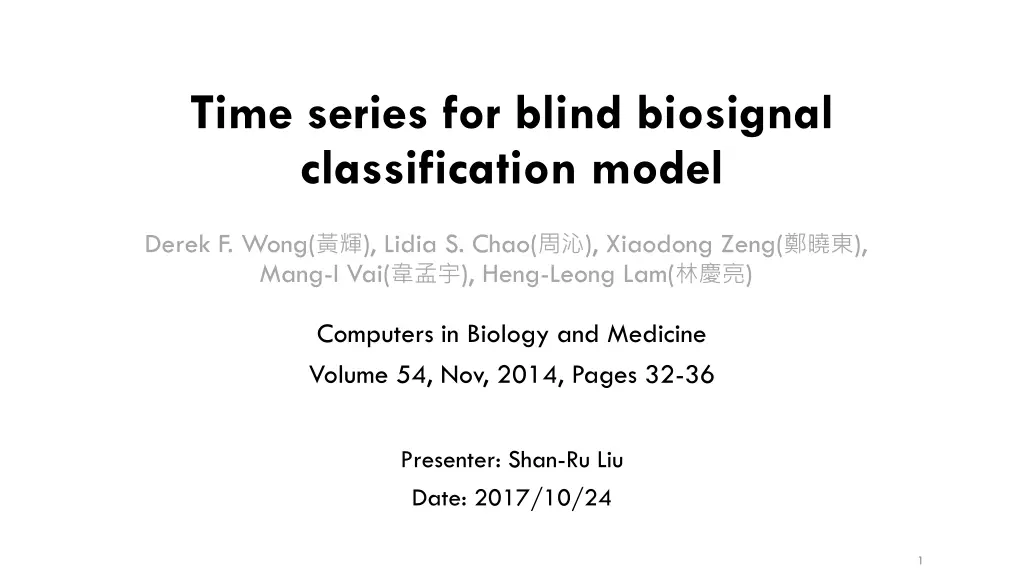
Blind Biosignal Classification Model for Health Monitoring
"Explore a blind biosignal classification model aimed at automating signal classification for improved disease diagnosis and health monitoring. Discover how the B2SC Model utilizes time series algorithms to identify biosignal types without prior knowledge, benefiting non-skilled users in managing their health conditions effectively."
Download Presentation

Please find below an Image/Link to download the presentation.
The content on the website is provided AS IS for your information and personal use only. It may not be sold, licensed, or shared on other websites without obtaining consent from the author. If you encounter any issues during the download, it is possible that the publisher has removed the file from their server.
You are allowed to download the files provided on this website for personal or commercial use, subject to the condition that they are used lawfully. All files are the property of their respective owners.
The content on the website is provided AS IS for your information and personal use only. It may not be sold, licensed, or shared on other websites without obtaining consent from the author.
E N D
Presentation Transcript
Time series for blind biosignal classification model Derek F. Wong( ), Lidia S. Chao( ), Xiaodong Zeng( ), Mang-I Vai( ), Heng-Leong Lam( ) Computers in Biology and Medicine Volume 54, Nov, 2014, Pages 32-36 Presenter: Shan-Ru Liu Date: 2017/10/24 1
Abstract Biosignals such as electrocardiograms (ECG), electroencephalograms (EEG), and electromyograms (EMG), are important noninvasive measurements useful for making diagnostic decisions. Recently, considerable research has been conducted in order to potentially automate signal classification for assisting in disease diagnosis. However, the biosignal type (ECG, EEG, EMG or other) needs to be known prior to the classification process. If the given biosignal is of an unknown type, none of the existing methodologies can be utilized. In this paper, a blind biosignal classification model (B2SC Model) is proposed in order to identify the source biosignal type automatically, and thus ultimately benefit the diagnostic decision. The approach employs time series algorithms for constructing the model. It uses a dynamic time warping (DTW) algorithm with clustering to discover the similarity between two biosignals, and consequently classifies disease without prior knowledge of the source signal type. The empirical experiments presented in this paper demonstrate the effectiveness of the method as well as the scalability of the approach. 2
Biosignals All kinds of signals that can be measured and monitored from biological beings. ECG (electrocardiogram) EEG (electroencephalogram) EMG (electromyogram) EOG (electrooculography) 3
Blind biosignal classification model (B2SC model) Purpose: 1. Enabling non-skilled home-based users to operate a multi-function biosignal acquisition device easily for monitoring and managing their health conditions 2. Helping to improve the diagnostic capability of a disease or symptom without knowing the exact type of source biosignal 3. Allowing the use of only one device and one sensor which could adapt to multiple biosignals 4
Blind biosignal classification model (B2SC model) Three major phase: 1. Biosignal template construction 2. Template optimization and management 3. Pattern matching Sample of different patterns from ECG signals Normal ECG Acute anterior myocardial infarction Acute inferior myocardial infarction Acute posterior myocardial infarction 5
Dynamic Time Warping (DTW) ? ?,? = ???? ?,? + min[? ? 1,? ,? ?,? 1 ,?(? 1,? 1)] Wk=( ? , ? ) Warping Path ?=? ???? ? = ???? ???,??? ?=1 ??? ? , ? ? ? + ? W1=(1,1) 7
Templates construction and optimization algorithm 1. Initialize k = # of categories for each type of biosignal; 2. Segment each biosignal into a number of one-cycle patterns; 3. Cluster all patterns into k classes by kNN algorithm; 4. For each k cluster, find a central (medoids) pattern of the cluster; 5. For each pattern p, calculate the distance between p and each medoids; Re-assign p to a cluster with nearest medoids; 6. For each cluster, calculate the distance among all p within a cluster; Assign a new medoids to p that has the minimum distance to other patterns; 7. If no more pattern can change the structure of clusters, retrieve the medoids and L nearest patterns for each cluster as the representatives; otherwise, repeat step 6. 8
Pattern matching phase of B2SC Model Input: 1. S = {S1,S2, ,Sm} : a blind biosignal 2. OpTem = {Pecg(i), Peeg(j); 0 i k, 0 j w} : the optimal representative biosignal templates 3. : threshold for determining the type of an input biosignal 9
Pattern matching phase of B2SC Model Output: Class = {ECG, EEG and Other} : the signal class 1. minecg <- Matching ECG templates and get the minimum similarity measurement 2. mineeg <- Matching EEG templates and get the minimum similarity measurement 3. mintp <- Compare minecg and mineeg to get the minimum similarity measurement among the signal templates 4. If mintp< , if mintp= minecg, output is ECG, else output is EEG 5. If mintp> , output is other biosignal 10
Pattern matching phase of B2SC Model Sim(P, S) = 0 ? ? ? ;?+ ? ? ?DTW(P, Sb,e) (1) ??? ? DTW(ET, EU) = min ?=1 ET = et1, , eti, , etn EU = eu1, , euj, , eum ?(??), and max(m, n) K m+n (2) d(wl) = d(eti, euj) = (eti, euj)2(3) DT(eti, euj) = d(eti, euj) + min{DT(eti-1, euj-1), DT(eti, euj-1), DT(etj-1,euj)} (4) 11
Experimental setting All data were divided into two disjunctive partitions : training set and test set, based on the10-fold cross validation method, and the ratio for training and test sets was 80% vs. 20%. The training set was used to construct the optimal biosignal templates, OpTem, and included ECG and EEG signals, whereas the test set was used for validation. The threshold was computed automatically by taking the maximum similarity score among all pairs of the optimal templates. 12
Classification results TP : True Positive FN : False Negative FP : False Positive TP Recall: TP+FN TP Precision: TP+FP F-score: 2 * ????????? ?????? ?????????+?????? = 2?? 2??+??+?? 13
